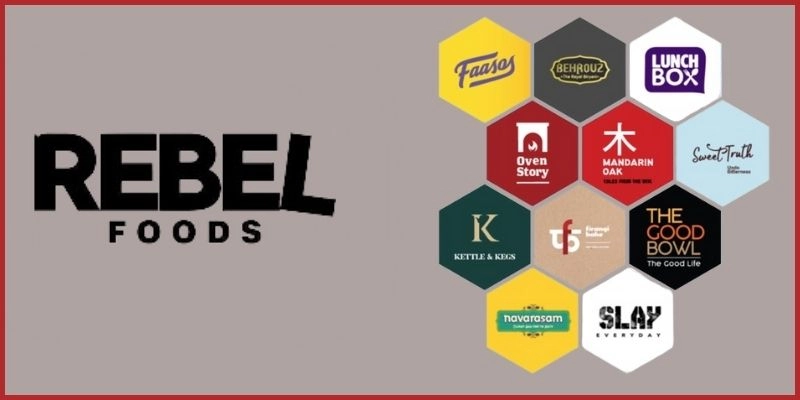Rebel Foods success story: After working a full day in the office, in a pile of files, and after listening to your boss’s orders, you reach home tired. You are very hungry. But there is no sign of food. Very few people know this, but the world’s biggest internet kitchen is in India.
Rebel Foods is a start-up from Bangalore that is a unicorn and made 1,258.7 Cr last year. Since 2011, they’ve disrupted India’s cloud kitchen industry, and they got there by kneeling four things, starting with their pivot into a cloud kitchen ball. You may not know Rebel Foods because that came much later. First there was Fasos.
But in reality, Faasos is not a restaurant. But it is a chain of restaurants. Which operates in the model cloud kitchen. This means a restaurant chain where not only one but multiple brands are running. This story starts in 2003, when Kallol Banerjee and Jaydeep Barman They both plan to do something that was not happening in India at that time.
Dreams were in the eyes, and passion was in the body. But there was a huge problem. That was how to start? No one knew that. Jaydeep was initially from Calcutta, but he used to stay in Pune. So their house and their culture, and especially missing food from there, were obvious. At that time, in Kolkata, Kathai roles were famous.

In fact, they are even famous today. But the same taste and the same Kathai roles Finding them in Pune was very hard. To do something, and the cravings of Kolkata roles Both of these things gave Jaydeep direction. And after that, there was the start of the role store. Today, you know me by the name “Faasos.”.
Efforts were showing their true colors. In 2003, they started with just one store. Until 2006, there were four stores. But, as it is said, time is never the same. The obstacles come. By leaving his store, which he made with lots of effort, Jaydeep went to France for his MBA. Two years have passed, and by forgetting his old life, he starts doing a job at McKinsey Company.
He did a job in London for some years and earned a lot of money. But as he was not having fun at his job, Jaydeep returned to India. From 2010 until now, Faasos was working, but because of a lack of focus on business, everything was stopped. Business growth was stopped. And success was very far away. And there was just one question in mind, Will Faasos ever be successful? Will we be able to do a successful business? But in no time, the day and night efforts were showing effects.
How Rebel Food Disrupted the Cloud Kitchen Industry
We need to zoom out to understand why cloud kitchens came up in the first place in India. What’s the real industry inside here? So let’s dig a little deeper here. The fundamental behavior of eating outside has always been there. Right now, before Swiggy, you would call the restaurant near you, and a guy from that restaurant would come and deliver your food to you.

This had a lot of problems. Those restaurants would charge for delivery; you couldn’t track the order; there was no discount; and it would take crazy amounts for this order to be delivered to you. This is the behavior that Swiggy came to disrupt. Remember, this is the India of 2014–2015, where massive urbanization was happening. People were moving to cities like Bangalore, Bombay, and Delhi, and access to homecooked food was reducing. Now Swiggy and Zomato were making this logistics heavy category of delivery.
turning it more into a lifestyle business plus this generation was Savvy and Instagram was helping with food po now the insight here is that Swiigy and Zomato are largely supply driven Mark places and we’ll dig deep into how they crack supply but see the consumer here is the same right you and me so the only way they make a good business is by increasing the food orders that we place in a month so the frequency of orders need to go up plus they also s discoverability right by opening a barrage of food options near you earlier
When you had just a couple of restaurants near you, you could eat outside, like once a month. Now, when these apps showed you 40 options, you started eating out twice a month, and so the question became, if I show you 80 options, will you eat out four times a month? Yes, people did, so supply solved retention. This changed the way people thought about food, and the frequency of ordering online went up.
So the solution was clear: supply will solve retention, but how will we keep increasing food options for people to order from? and the frequency of them ordering food will go up makes sense right so the idea became clear open as many restaurants as possible, but there’s one problem here is Capex.
This is where Cloud Kitchens makes an entry. The foundational insight for food delivery to emerge and succeed as a category in India is that they have to democratize the supply side which basically means that the number of options to order from has to increase.
List of brands owned by Rebel Food

1. Faasos
2. Behrouz Biryani
3. Oven Story Pizza
4. Mandarin Oak
5. Firangi Bake
6. Lunch Box
7. The Good Bowl
8. Sweet Truth
9. The Biryani Life
10. Wendy’s
11. Nude Bowls by Maliaka Arora
12. The 500 Calorie Project
13. Box & Co.
14. Ayam Ambyar
15. Bros Fried Chicken
16. Feeling Bren
17. Banzai
18. Boom Burger
19. Holy Cow
20. Sawa
Rebel Food Marketing Strategy
Rebel Food’s marketing strategy focuses on disrupting the traditional food industry by offering unique and creative food options that cater to a rebellious and non-conformist audience. This is achieved through a combination of unconventional branding, targeted social media campaigns, and strategic partnerships.

One key aspect of Rebel Food’s marketing strategy is its use of digital platforms to engage with its target audience. This includes utilizing social media platforms such as Instagram and Facebook to showcase their rebellious and unique food options, as well as driving customer engagement through user-generated content and influencer partnerships.
Another important element of Rebel Food’s marketing strategy is its emphasis on creating a unique and memorable brand image. This is achieved through bold and edgy branding that appeals to the rebellious nature of the company’s target audience. This distinct branding not only differentiates Rebel Food from its competitors but also helps to create a strong sense of brand loyalty among its customers.
Rebel Food also strategically partners with other rebellious or non-traditional brands and events to further align its brand with its target market. This can include collaborations with hipster music festivals, streetwear brands, or other alternative food and beverage companies.
Overall, Rebel Food’s marketing strategy is focused on creating a strong brand identity, engaging with its target audience through digital platforms, and forming strategic partnerships to reach and resonate with its rebellious customer base.
conclusion:
Rebel Foods is a prime example of how a small idea can grow into a successful business by identifying and filling a gap in the market. Its innovative business model, use of technology, and strategic partnerships have played a crucial role in its growth and success story. With its potential for further expansion and impact on the food industry, Rebel Foods is a company to watch out for in the coming years.

The creative mind behind your go-to blog for an engaging blend of entertainment, business, finance and Automobile. backed by four years of industry work experience. With a passion for storytelling and a knack for simplifying complex topics, Saif brings you insightful perspectives on the entertainment industry, dissecting the latest movies, while also providing practical insights into the business and finance realms.


